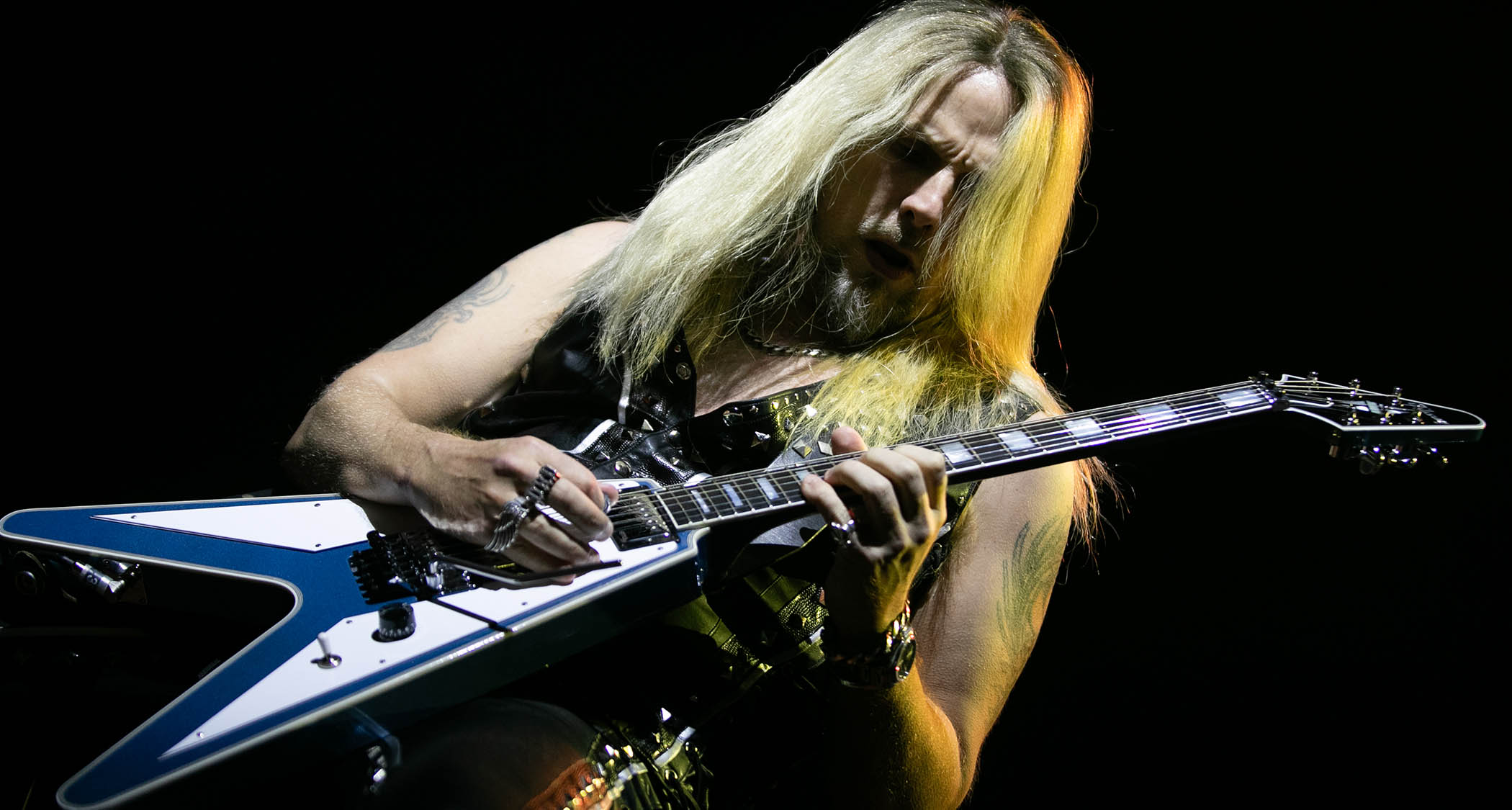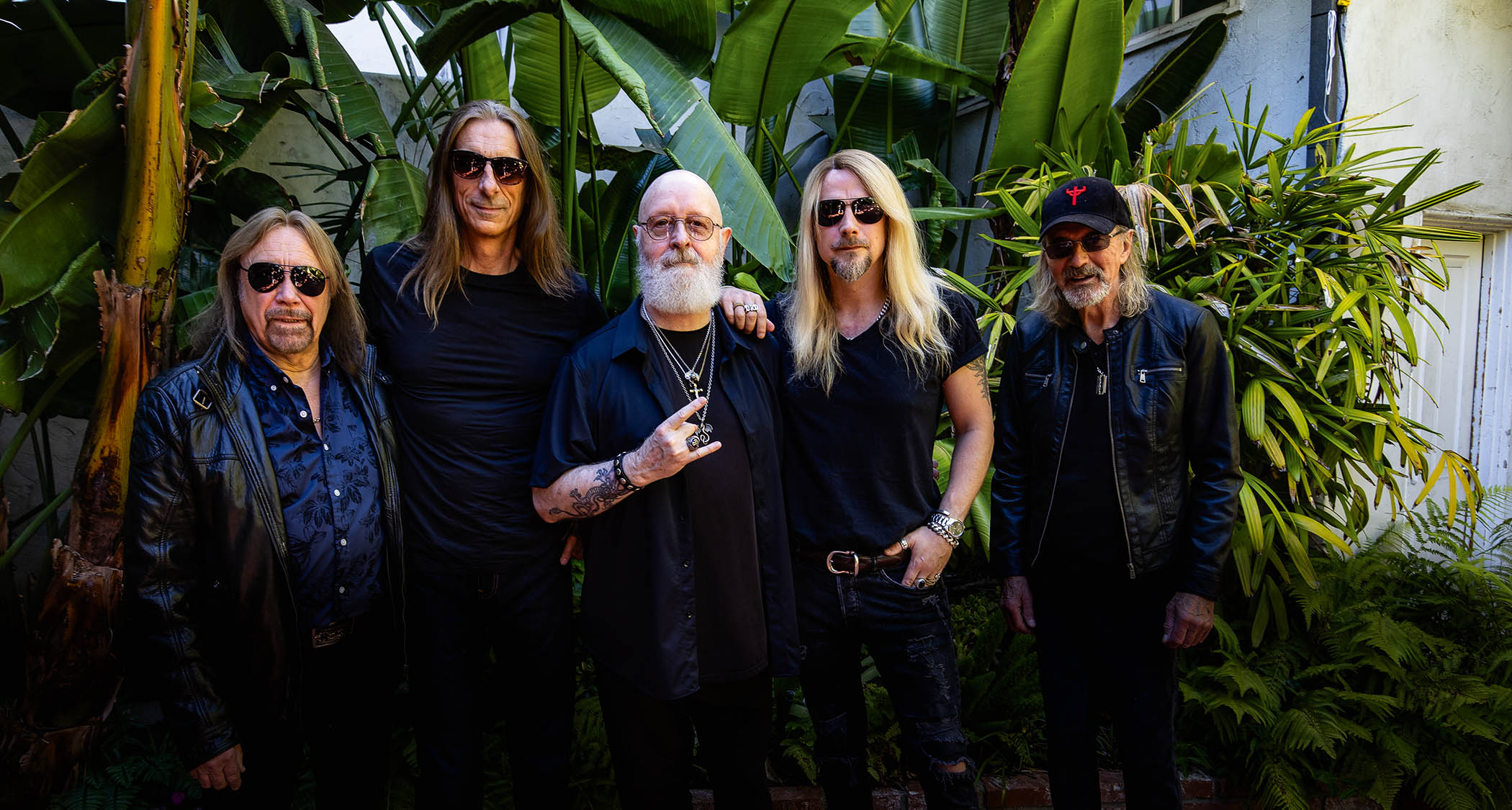
There are certain things to be expected from a Judas Priest album. When it comes to mid-tempo, palm-muted minor riffing, screaming harmonised leads and distorted tones that feel hotter than the sun, you know you’re in safe hands.
But even by their own standards, the heavy metal pioneers are truly going for gold on this year’s 19th studio album Invincible Shield – rammed with explosive fretwork, from the rapid-fire brilliance of opening track Panic Attack to the biker blues of finale Giants In The Sky.
It will undoubtedly be one of the finest metal albums you’ll hear this year, and more impressively manages to stand shoulder-to-shoulder with classic Priest albums such as Stained Class, British Steel and Screaming For Vengeance.
The road to this point has not been easy, however. In 2018, guitarist Glenn Tipton, a member of Priest since 1974, revealed he’d be stepping down from touring after an ongoing struggle with Parkinson’s, forcing the band to rope in their producer Andy Sneap as a touring guitarist.
And in 2021, Richie Faulkner, who replaced K.K. Downing a decade prior, suffered from a near-fatal aortic aneurysm while Priest were performing on stage at Kentucky’s Louder Than Life festival.
After a 10-hour open-heart procedure in which five parts of his chest were replaced by mechanical components, Richie lived to tell the tale and to continue playing a vital role in this legendary band…
This new album feels extra special, given everything that’s happened. Like the lyrics from Priest’s 1982 track Electric Eye, you are now actually made of metal!
“Literally, because there are metal parts in my chest! Part of the healing process was getting back out there and finishing this record. I got back on the horse and rode on. As you say, all of this may never have happened and that does put a different perspective on things. You never know what’s around the corner.
“I don’t know if Rob [Halford, vocalist] was referring to that when he came up with the title Invincible Shield. It’s a reference to the metal community in general. We’re proud metal fans and this music is like an invincible shield.
“We all go through challenges. What doesn’t kill you makes you stronger. Glenn’s had his struggles, I’ve had things, Rob’s been through it as well, but we live to fight another day!”
We all go through challenges. What doesn’t kill you makes you stronger. Glenn’s had his struggles, I’ve had things, Rob’s been through it as well, but we live to fight another day!
Maybe that’s why the latest material ended up being such a masterclass in technicality? The solo sections feel more orchestrated, with light-speed diminished sweeps and alternate-picked ideas…
“Priest have been through many stages, from proggy stuff like Sinner and Tyrant [from the late ’70s] to straight-up metal. Because we had more time to develop our ideas after the pandemic, we came up with sections that felt like the stuff that Randy Rhoads did with Ozzy Osbourne.
“Moments that are a song within a song. The music goes somewhere else before coming back. You have to be careful, though – it can become a bad thing if you go too far! As for the diminished stuff, some of it’s definitely from Glenn after 13 years of playing together…”
It’s only natural that you’d end up inheriting some of these technical nuances, right?
“If you do your best to recreate what’s on the record, you can’t help Glenn and K.K.’s solos becoming a part of your style. As for sweeping, I’ve never swept. I’m good at sweeping the floor, that’s about it! I’m still learning, to be honest. I find it helps if the angle of my picking hand changes when I’m coming back up, though I only just realised! I’m discovering all the time.
“I’ve been doing the Painkiller solo ever since Glenn couldn’t play with us, which works out as a lot of Painkiller solos! You have to nail that starting lick as faithfully as you can. I try my best not to mess up.
“Doing that night after night helps build the technique. Some of these new solos called for a similar approach, maybe sweeping half the strings, a few notes in the middle and then sweeping through the remaining ones. I’m getting better at it, but I’m also blagging half of it!”
How do you go about splitting the parts? Do you divide everything in half and taking turns?
“We ask ourselves if the song feels like it needs to go somewhere else, in a new direction. If not, we stick to one solo and get back to the vocals. Obviously, with Glenn’s situation, he wasn’t playing as much lead as before. But that’s okay, we didn’t want that to impede the process. If Glenn was having a good day, he’d play the part. If he couldn’t, I’d do it.
“We didn’t want him to worry. He brought songs to the table like Sons Of Thunder which is a classic three-minute track in the style of [Priest anthem] Hell Bent For Leather. Glenn is the master of that stuff. He was as involved as he could be and it was important for us to involve him.”
I wish I knew what you’re talking about with all that Dorian and Aeolian stuff! But I know that there’s a minor sound, a major sound, a diminished sound. If you asked me to play those scales, I wouldn’t know
So what do you think are the characteristics of a classic Judas Priest riff?
“It’s hard to say; they’re so diverse. From You’ve Got Another Thing Coming and Painkiller to Victim Of Changes and Killing Machine, they’re all vastly different, you know? That’s the beauty of Priest. Because of that diversity, a lot of ideas can go on the table and most of them will be appropriate.
“I definitely think a great riff should make you bang your head and hit you in the face. Classic Priest riffs have to be simple enough to be accessible but complex enough to be fucking great. If it makes you pull a mean face, it’s a good one!”
The large majority of these riffs live in the Aeolian minor world rather than, say, Dorian minor with the major 6th. Do you think much about the building blocks and the maths behind it?
“Not at all. I wish I knew what you’re talking about with all that Dorian and Aeolian stuff! But I know that there’s a minor sound, a major sound, a diminished sound.
“If you asked me to play those scales, I wouldn’t know. If you showed me, I’d say ‘Oh yeah, that’s the same as The Sentinel or whatever!’ But I’m just not that way inclined. It’s too mathematical for me. Sometimes what doesn’t work theoretically can be powerful, too. There’s been some major stuff in the past, but you’re right, it’s usually minor.”
I don’t normally construct solos. I’ll go into the studio and play a few back-to-back. Certain motifs will jump out
There’s that minor legato line built around the 12th to the 15th and 19th frets, similar to some classic Eddie Van Halen and Randy Rhoads runs…
“I don’t normally construct solos. I’ll go into the studio and play a few back-to-back. Certain motifs will jump out. If they stick, you’re subconsciously telling yourself that’s what needs to go there. But this time I actually had that stretched part you’re talking about first, and then constructed the rest around that. Later, Andy Sneap asked if I could harmonise the end bit.”
Songs like The Serpent And The King and Sons Of Thunder have some challenging picked runs. Do you play strict alternate or is there some economy in there?
“I don’t quite know what I’m doing half the time, but it’s definitely not strict alternate. I don’t pick everything, I can’t do that! There’s a lot of down-up-down-down moves with me. Your right hand is as valuable as your left. It’s all well and good flying around with your fretting hand but the picking hand is the machine that drives the attack. It’s the engine, whether we’re talking about Priest or James Hetfield’s right hand in Metallica.
“And actually it’s a part of metal guitar playing that often gets neglected. Zakk Wylde is a major influence, he picks everything incredibly. I’m somewhere in the middle: I love Michael Schenker and Dave Murray from Iron Maiden; the latter of whom is a legato player. The downstroke is the law in metal, at least in a lot of people’s minds, but I play some riffs starting on the up.”
Devil In Disguise and Gates Of Hell typify the more bluesy side of your playing. A lot of heart and soul with some flat 5ths, for good measure…
“Sometimes we don’t know when to shut up when we’re younger, but as you grow you realise that the slower, more melodic ideas connect more. You can stand there and do a million notes a second, but it won’t work as well as stuff like [Pink Floyd’s] Comfortably Numb or [Queen’s] Killer Queen.
“I was playing covers in pubs for years, learning different styles. I don’t feel like I’ve ever been a shredder. I’m never going to out-do Yngwie Malmsteen or Eric Johnson. I’m more from the Schenker and Ritchie Blackmore school.
“Devil In Disguise felt like a Blackmore kind of thing. There’s a time for the fast stuff, but if you want to connect emotionally, it’s almost always better slower. I try to find different ways of saying unique things. That’s a lot harder than it sounds, taking your favourite notes and discovering new ways to use them.”

You’ve stuck with Gibson Les Pauls, Flying Vs and Explorers over the years. Is that what we’re hearing on the record?
“There were three guitars: one of them was a prototype for last year’s Pelham Blue Flying V signature. I had an old black Les Paul Custom from 1976 which I painted white when I joined Priest. It’s the most sonically balanced guitar I’ve got.
“I used it for all the rhythms on the Firepower album. The highs are all in the right place and it’s well balanced tonally. That one still has the EMG 81/85 set. An Explorer I use live is on the record, too.”
For shows I’ve started using the Wampler Tumnus, which I think sounds better than the original Klon!
You rely on Engl and Wizard guitar amps on stage. Is it the same for recording?
“I ended up recording at my place. I’d run my Quad Cortex into the desk and keep the DI, because I’m not technical when it comes to mics and speakers. That’s more for producers and engineers. So I’d send the DIs to Andy who would then re-amp through JCM 800s and newer EVH heads.
“I don’t know what pedal went in front, but there definitely would’ve been something. For shows I’ve started using the Wampler Tumnus, which I think sounds better than the original Klon!”
So what is the hardest track on this album to nail?
“The songs have only been out a couple of minutes and some players have got it down already, probably better than I ever could! I’ve seen covers where everything’s picked and sounds proper.
“The title track is a challenge with all the different parts, and As God Is My Witness is another, because it involves fast picking from the get-go. They’re both challenging, but if you’re anything like me, it’s all good fun!”
- Invincible Shield is out now via Epic.







